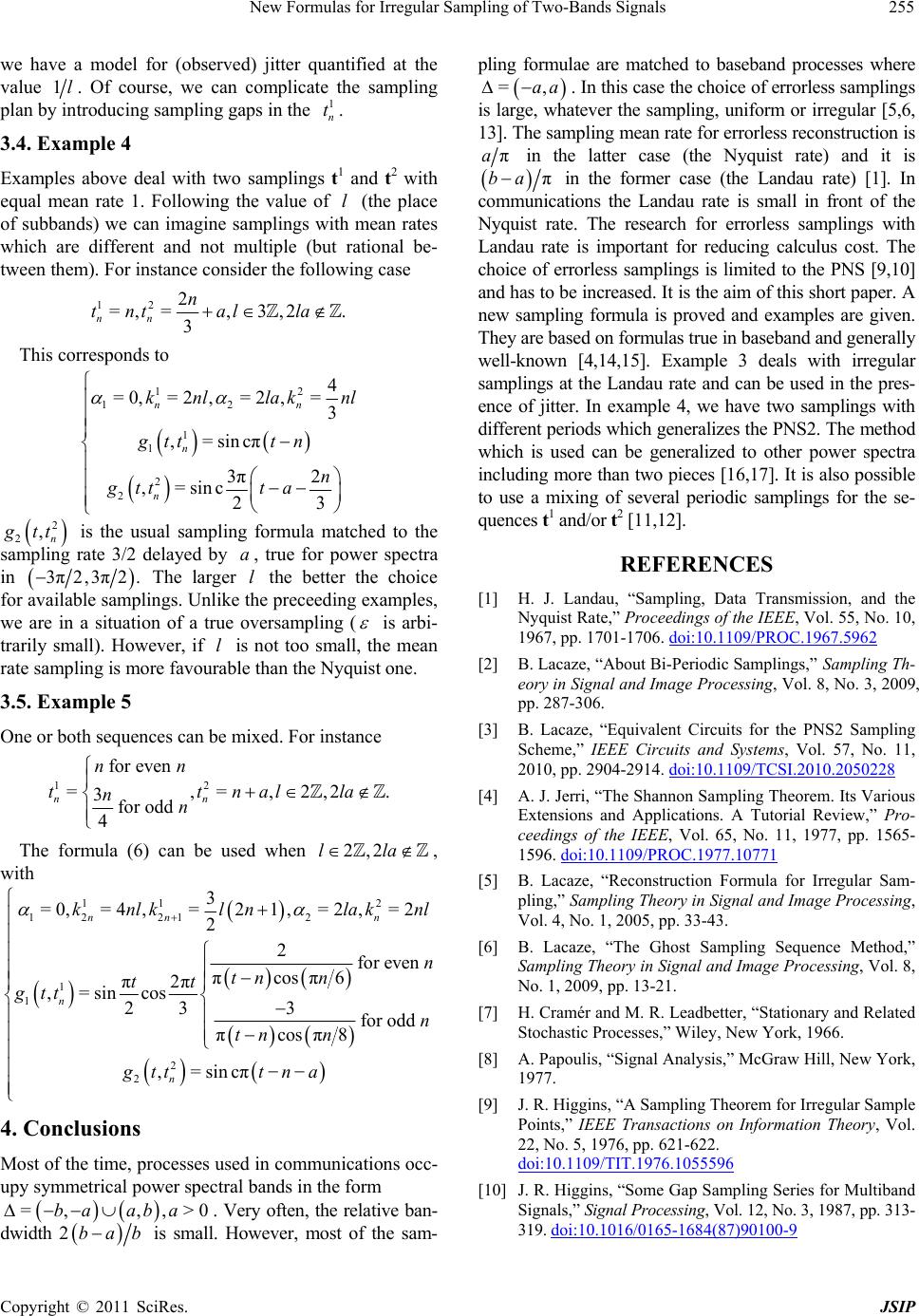
New Formulas for Irregular Sampling of Two-Bands Signals255
we have a model for (observed) jitter quantified at the
value 1l. Of course, we can complicate the sampling
plan by introducing sampling gaps in the .
1
n
t
3.4. Example 4
Examples above deal with two samplings t1 and t2 with
equal mean rate 1. Following the value of (the place
of subbands) we can imagine samplings with mean rates
which are different and not multiple (but rational be-
tween them). For instance consider the following case
l
12
2
=, =,3,2.
3
nn
n
tntalla
This corresponds to
12
12
1
1
2
2
4
=0,=2,=2 ,=3
,=sincπ
3π2
,=sinc
23
nn
n
n
knllakn
gtt tn
n
gtt ta
l
2
2,n
tt is the usual sampling formula matched to the
sampling rate 3/2 delayed by , true for power spectra
in
a
3π2,3π2.
The larger the better the choice
for available samplings. Unlike the preceeding examples,
we are in a situation of a true oversampling (
l
is arbi-
trarily small). However, if is not too small, the mean
rate sampling is more favourable than the Nyquist one.
l
3.5. Example 5
One or both sequences can be mixed. For instance
12
for even
=,=,2,2
3for odd
4
nn
nn
ttnal
nn
.la
The formula (6) can be used when ,
with
2,2lla
11 2
12 212
1
1
2
2
3
=0,=4,=21,=2,=2
2
2for even
πcosπ6
π2π
,=sincos 3
23 for odd
πcos π8
,=sincπ
nn n
n
n
knlk lnlakn
n
tn n
tt
gtt
n
tn n
gtt tna
l
0
4. Conclusions
Most of the time, processes used in communications occ-
py symmetrical power spectral bands in the form u
=, ,,>ba aba
. Very often, the relative ban-
dwidth 2bab is small. However, most of the sam-
pling formulae are matched to baseband processes where
=,aa . In this case the choice of errorless samplings
is large, whatever the sampling, uniform or irregular [5,6,
13]. The sampling mean rate for errorless reconstruction is
πa in the latter case (the Nyquist rate) and it is
πba in the former case (the Landau rate) [1]. In
communications the Landau rate is small in front of the
Nyquist rate. The research for errorless samplings with
Landau rate is important for reducing calculus cost. The
choice of errorless samplings is limited to the PNS [9,10]
and has to be increased. It is the aim of this short paper. A
new sampling formula is proved and examples are given.
They are based on formulas true in baseband and generally
well-known [4,14,15]. Example 3 deals with irregular
samplings at the Landau rate and can be used in the pres-
ence of jitter. In example 4, we have two samplings with
different periods which generalizes the PNS2. The method
which is used can be generalized to other power spectra
including more than two pieces [16,17]. It is also possible
to use a mixing of several periodic samplings for the se-
quences t1 and/or t2 [11,12].
REFERENCES
[1] H. J. Landau, “Sampling, Data Transmission, and the
Nyquist Rate,” Proceedings of the IEEE, Vol. 55, No. 10,
1967, pp. 1701-1706. doi:10.1109/PROC.1967.5962
[2] B. Lacaze, “About Bi-Periodic Samplings,” Sampling Th-
eory in Signal and Image Processing, Vol. 8, No. 3, 2009,
pp. 287-306.
[3] B. Lacaze, “Equivalent Circuits for the PNS2 Sampling
Scheme,” IEEE Circuits and Systems, Vol. 57, No. 11,
2010, pp. 2904-2914. doi:10.1109/TCSI.2010.2050228
[4] A. J. Jerri, “The Shannon Sampling Theorem. Its Various
Extensions and Applications. A Tutorial Review,” Pro-
ceedings of the IEEE, Vol. 65, No. 11, 1977, pp. 1565-
1596. doi:10.1109/PROC.1977.10771
[5] B. Lacaze, “Reconstruction Formula for Irregular Sam-
pling,” Sampling Theory in Signal and Image Processing,
Vol. 4, No. 1, 2005, pp. 33-43.
[6] B. Lacaze, “The Ghost Sampling Sequence Method,”
Sampling Theory in Signal and Image Processing, Vol. 8,
No. 1, 2009, pp. 13-21.
[7] H. Cramér and M. R. Leadbetter, “Stationary and Related
Stochastic Processes,” Wiley, New York, 1966.
[8] A. Papoulis, “Signal Analysis,” McGraw Hill, New York,
1977.
[9] J. R. Higgins, “A Sampling Theorem for Irregular Sample
Points,” IEEE Transactions on Information Theory, Vol.
22, No. 5, 1976, pp. 621-622.
doi:10.1109/TIT.1976.1055596
[10] J. R. Higgins, “Some Gap Sampling Series for Multiband
Signals,” Signal Processing, Vol. 12, No. 3, 1987, pp. 313-
319. doi:10.1016/0165-1684(87)90100-9
Copyright © 2011 SciRes. JSIP